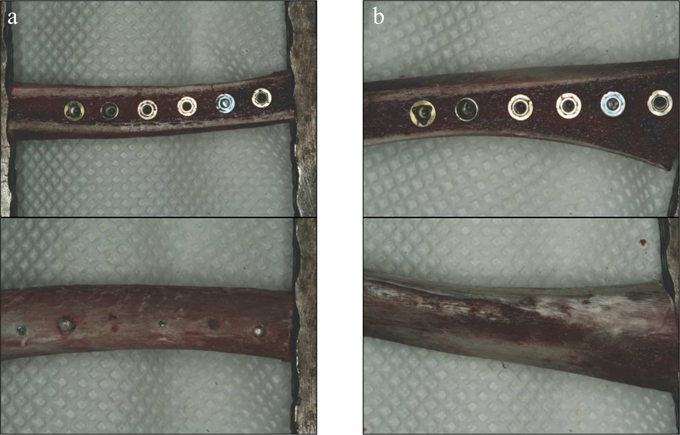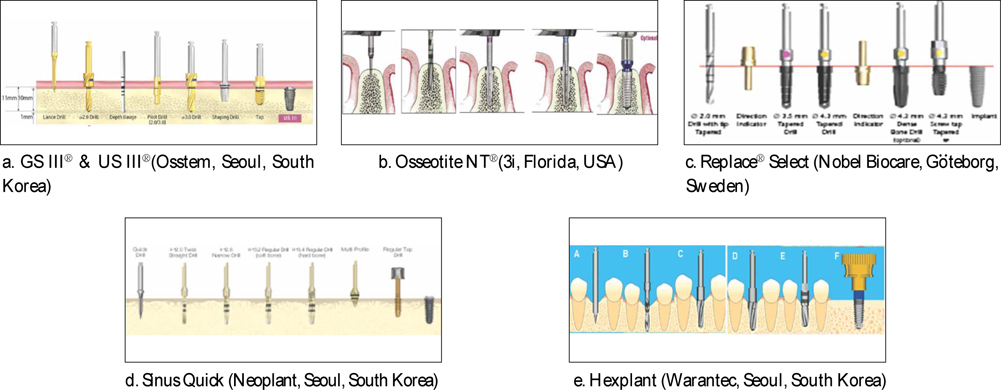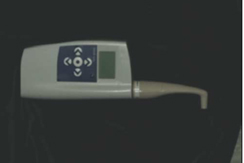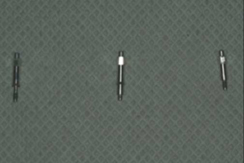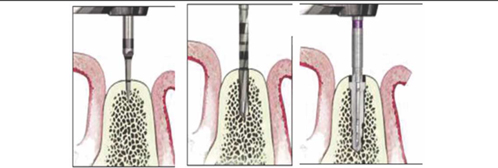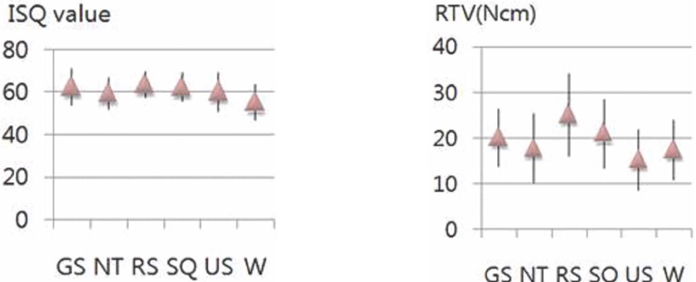J Adv Prosthodont.
2009 Mar;1(1):19-25. 10.4047/jap.2009.1.1.19.
The effect of various thread designs on the initial stability of taper implants
- Affiliations
-
- 1Department of Prosthodontics, Graduate School, Seoul National University, Seoul, Korea. limdds@snu.ac.kr
- KMID: 2176335
- DOI: http://doi.org/10.4047/jap.2009.1.1.19
Abstract
- STATEMENT OF PROBLEM: Primary stability at the time of implant placement is related to the level of primary bone contact. The level of bone contact with implant is affected by thread design, surgical procedure and bone quality, etc. PURPOSE: The aim of this study was to compare the initial stability of the various taper implants according to the thread designs, half of which were engaged to inferior cortical wall of type IV bone (Group 1) and the rest of which were not engaged to inferior cortical wall (Group 2) by measuring the implant stability quotient (ISQ) and the removal torque value (RTV). MATERIAL AND METHODS: In this study, 6 different implant fixtures with 10 mm length were installed. In order to simulate the sinus inferior wall of type IV bone, one side cortical bone of swine rib was removed. 6 different implants were installed in the same bone block following manufacturer's recommended procedures. Total 10 bone blocks were made for each group. The height of Group 1 bone block was 10 mm for engagement and that of group 2 was 13 mm. The initial stability was measured with ISQ value using Osstell mentor(R) and with removal torque using MGT50 torque gauge. RESULTS: In this study, we found the following results. 1. In Group 1 with fixtures engaged to the inferior cortical wall, there was no significant difference in RTV and ISQ value among the 6 types of implants. 2. In Group 2 with fixtures not engaged to the inferior cortical wall, there was significant difference in RTV and ISQ value among the 6 types of implants (P < .05). 3. There was significant difference in RTV and ISQ value according to whether fixtures were engaged to the inferior cortical wall or not (P < .05). 4. Under-drilling made RTV and ISQ value increase significantly in the NT implants which had lower RTV and ISQ value in Group 2 (P < .05). CONCLUSIONS: Without being engaged to the inferior cortical wall fixtures had initial stability affected by implant types. Also in poor quality bone, under-drilling improved initial stability.
Figure
Cited by 3 articles
-
The seven-year cumulative survival rate of Osstem implants
Young-Kyun Kim, Bum-Su Kim, Pil-Young Yun, Sang-Un Mun, Yang-Jin Yi, Su-Gwan Kim, Kyung-In Jeong
J Korean Assoc Oral Maxillofac Surg. 2014;40(2):68-75. doi: 10.5125/jkaoms.2014.40.2.68.The effects of local factors on the survival of dental implants: A 19 year retrospective study
Sung Hoi Kim, Sunjai Kim, Keun-Woo Lee, Dong-Hoo Han
J Korean Acad Prosthodont. 2010;48(1):28-40. doi: 10.4047/jkap.2010.48.1.28.Analysis of thermal changes in bone by various insertion torques with different implant designs
Min-Ho Kim, In-Sung Yeo, Sung-Hun Kim, Jung-Seok Han, Jai-Bong Lee, Jae-Ho Yang
J Korean Acad Prosthodont. 2011;49(2):168-176. doi: 10.4047/jkap.2011.49.2.168.
Reference
-
1. Scarano A, Degidi M, Iezzi G, Petrone G, Piattelli A. Correlation between implant stability quotient and bone-implant contact: a retrospective histological and histomorphometrical study of seven titanium implants retrieved from humans. Clin Implant Dent Relat Res. 2006. 8:218–222.2. O'Sullivan D, Sennerby L, Meredith N. Measurements comparing the initial stability of five designs of dental implants: a human cadaver study. Clin Implant Dent Relat Res. 2000. 2:85–92.3. Alsaadi G, Quirynen M, Michiels K, Jacobs R, van Steenberghe D. A biomechanical assessment of the relation between the oral implant stability at insertion and subjective bone quality assessment. J Clin Periodontol. 2007. 34:359–366.4. Johansson P, Strid KG. Assessment of bone quality from placement resistance during implant surgery. Int J Oral Maxillofac Implants. 1994. 9:279–288.5. Tricio J, Laohapand P, van Steenberghe D, Quirynen M, Naert I. Mechanical state assessment of the implant-bone continuum: a better understanding of the Periotest method. Int J Oral Maxillofac Implants. 1995. 10:43–49.6. Rasmusson L, Meredith N, Kahnberg KE, Sennerby L. Stability assessments and histology of titanium implants placed simultaneously with autogenous onlay bone in the rabbit tibia. Int J Oral Maxillofac Surg. 1998. 27:229–235.7. Ueda M, Matsuki M, Jacobsson M, Tjellström A. Relationship between insertion torque and removal torque analyzed in fresh temporal bone. Int J Oral Maxillofac Implants. 1991. 6:442–447.8. Ivanoff CJ, Gröndahl K, Sennerby L, Bergström C, Lekholm U. Influence of variations in implant diameters: a 3- to 5-year retrospective clinical report. Int J Oral Maxillofac Implants. 1999. 14:173–180.9. Steigenga JT, al-Shammari KF, Nociti FH, Misch CE, Wang HL. Dental implant design and its relationship to long-term implant success. Implant Dent. 2003. 12:306–317.10. Block CM, Tillmanns HW, Meffert RM. Histologic evaluation of the LaminOss osteocompressive dental screw: a pilot study. Compend Contin Educ Dent. 1997. 18:676–680. 682–684. –685.11. Balleri P, Cozzolino A, Ghelli L, Momicchioli G, Varriale A. Stability measurements of osseointegrated implants using Osstell in partially edentulous jaws after 1 year of loading: a pilot study. Clin Implant Dent Relat Res. 2002. 4:128–132.12. Miyamoto I, Tsuboi Y, Wada E, Suwa H, Iizuka T. Influence of cortical bone thickness and implant length on implant stability at the time of surgery--clinical, prospective, biomechanical, and imaging study. Bone. 2005. 37:776–780.13. Nkenke E, Hahn M, Weinzierl K, Radespiel-Tröger M, Neukam FW, Engelke K. Implant stability and histomorphometry: a correlation study in human cadavers using stepped cylinder implants. Clin Oral Implants Res. 2003. 14:601–609.14. Ostman PO, Hellman M, Wendelhag I, Sennerby L. Resonance frequency analysis measurements of implants at placement surgery. Int J Prosthodont. 2006. 19:77–83.15. da Cunha HA, Francischone CE, Filho HN, de Oliveira RC. A comparison between cutting torque and resonance frequency in the assessment of primary stability and final torque capacity of standard and TiUnite single-tooth implants under immediate loading. Int J Oral Maxillofac Implants. 2004. 19:578–585.16. Zix J, Kessler-Liechti G, Mericske-Stern R. Stability measurements of 1-stage implants in the maxilla by means of resonance frequency analysis: a pilot study. Int J Oral Maxillofac Implants. 2005. 20:747–752.17. Rocci A, Martignoni M, Burgos PM, Gottlow J, Sennerby L. Histology of retrieved immediately and early loaded oxidized implants: light microscopic observations after 5 to 9 months of loading in the posterior mandible. Clin Implant Dent Relat Res. 2003. 5:88–98.18. Rabel A, Köhler SG, Schmidt-Westhausen AM. Clinical study on the primary stability of two dental implant systems with resonance frequency analysis. Clin Oral Investig. 2007. 11:257–265.19. Fernandes Ede L, Unikowski IL, Teixeira ER, da Costa NP, Shinkai RS. Primary stability of turned and acid-etched screw-type implants: a removal torque and histomorphometric study in rabbits. Int J Oral Maxillofac Implants. 2007. 22:886–892.20. Akkocaoglu M, Cehreli MC, Tekdemir I, Comert A, Güzel E, Dağdeviren A, Akca K. Primary stability of simultaneously placed dental implants in extraoral donor graft sites: a human cadaver study. J Oral Maxillofac Surg. 2007. 65:400–407.21. Niimi A, Ozeki K, Ueda M, Nakayama B. A comparative study of removal torque of endosseous implants in the fibula, iliac crest and scapula of cadavers: preliminary report. Clin Oral Implants Res. 1997. 8:286–289.
- Full Text Links
- Actions
-
Cited
- CITED
-
- Close
- Share
- Similar articles
-
- Mechanical analysis of the taper shape and length of orthodontic mini-implant for initial stability
- The effect of the thread depth on the mechanical properties of the dental implant
- The Three Dimensional Finite Element Analysis of Stress according to Implant Thread Design under the Axial Load
- Optimization of orthodontic microimplant thread design
- The influence of thread geometry on implant osseointegration under immediate loading: a literature review



